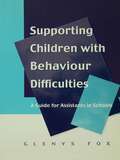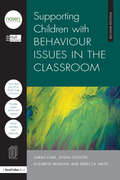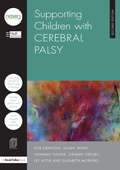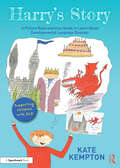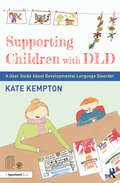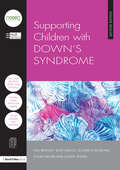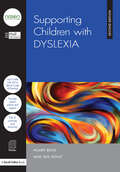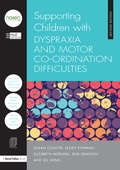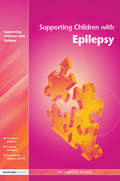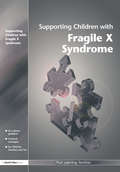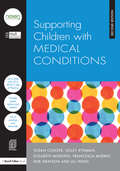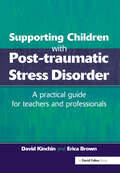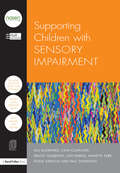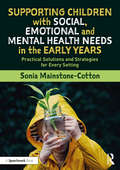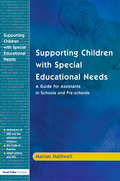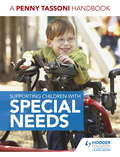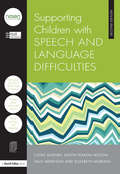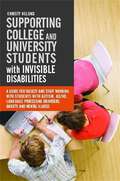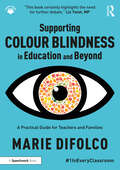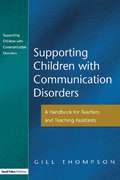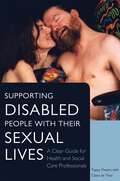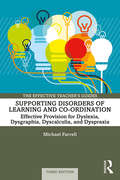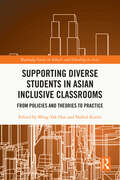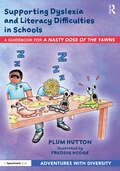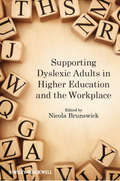- Table View
- List View
Supporting Children with Behaviour Difficulties: A Guide for Assistants in Schools
by Glenys FoxThis practical guide is written to help assistants in supporting children who have behavior difficulties. The author provides a description of the role of the assistant in working with the class teacher to enable children to learn good behavior in schools, a clear description of the range of behavior difficulties, and information on strategies that work in managing behavior. The book is relevant and useful for any assistant working directly with children, as all assistants in the course of their work need to develop a repertoire of effective strategies for managing behavior. It is particularly helpful for assistants who work routinely with children who present behavior problems as it guides understanding and provides a helpful framework for knowing where to start, what to do and how to do it. The book is also an invaluable resource in the training of assistants.
Supporting Children with Behaviour Issues in the Classroom
by Hull City CouncilThis completely revised edition is an easy to use resource for teachers, TAs and SENCOs concerned about behavioural issues in the classroom. It will support school staff in their approach to a range of behavioural issues, through a range of tried-and-tested strategies, including: How to create an environment of support and acceptance Techniques to provide an effective leaning environment Ways in which to communicate clearly with children with poor communication skills Whole class and whole school approaches for a positive learning environment How to maintain appropriate behaviours during unstructured break times This accessible reference tool will help any teacher to create and maintain a classroom environment conducive to learning. Packed with resources, it also includes templates and example Personal Support Plans, written by practitioners for practitioners.
Supporting Children with Cerebral Palsy (nasen spotlight)
by Hull City CouncilCompletely revised and fully updated in light of the 2014 SEND Code of Practice, this edition familiarises readers with the specific learning needs of cerebral palsy. Offering practical tips and tried-and-tested strategies from professional practitioners, this accessible guide provides advice on how to meet the needs of young people with cerebral palsy. This new edition presents all of the information practitioners will need to know to deliver outstanding provision for young people with cerebral palsy and support the inclusion of children and young people with cerebral palsy into mainstream schools. The far-reaching advice found within this guide includes: Planning for a pupil with cerebral palsy Accessing the curriculum, including specific advice on each subject area How to make effective use of support staff Developing independence skills Liaising between home and school Making the transition into adulthood With accessible materials, such as checklists, templates and photocopiable resources, this up-to-date guide will enable teachers and other professionals to feel more confident and effective in the support they can provide.
Supporting Children with DLD: A Picture Book and User Guide to Learn About Developmental Language Disorder (Supporting Children with DLD)
by Kate KemptonThis picture book and guidebook set has been developed to help raise awareness of Developmental Language Disorder, and to highlight the impact of DLD from the child’s point of view. Harry’s Story introduces a child who faces daily challenges in school due to his language difficulties. It explores how these challenges are made easier by his teachers’ understanding and support as he finds new ways to communicate. Supporting Children with DLD provides essential information, prompts and suggestions for adults to help understand the experience of children with DLD. It offers supportive strategies and activities to help children express themselves effectively and ask for help when they need it. This resource can be used both directly with the child, to talk about and explore DLD, and also as a training tool with the parents and professionals who support them. With research suggesting an average of two children per classroom are affected by DLD, this is an essential set for parents and professionals looking to understand the condition.
Supporting Children with DLD: A User Guide About Developmental Language Disorder (Supporting Children with DLD)
by Kate KemptonFor effective use, this book should be purchased alongside the illustrated picture book Harry’s Story. Both books can be purchased together as a set, Supporting Children with DLD: A Picture Book and User Guide to Learn About Developmental Language Disorder [978-0-367-70920-4]. Supporting Children with DLD, has been developed to help raise awareness of Developmental Language Disorder, and to highlight the impact of the condition from the child’s point of view. With activities, prompts and sample questions, this is an essential resource to enable adults to understand the reality of living with DLD, helping children feel heard and respected, as well as providing a solid foundation for tailoring support to individual needs. Drawing on specific examples from Harry’s Story, the book does not assume any prior knowledge of DLD and is designed to offer the reader accessible information and practical advice, teaching as you go. This book: Highlights the link between spoken and written language, addressing the need to recognise the literary difficulties faced by children with DLD Provides practical activities and worksheets that can be used to help children express themselves and ask for help Offers strategies for supporting children’s understanding of language, based on common situations and experiences explored in Harry’s Story Written to be an accessible introduction to DLD and its effect on children’s lives, this is an essential resource for parents and professionals looking to understand the condition.
Supporting Children with Down's Syndrome (nasen spotlight)
by Hull City CouncilThis practical resource contains a wealth of valuable advice and tried-and-tested strategies for supporting children and young people with Down’s Syndrome. Fully updated with the 2014 SEND Code of Practice, this text describes the different types of difficulties experienced by pupils with Down’s Syndrome and helps practitioners to understand their diverse needs. The wide-ranging chapters explore a variety of topics, including: Defining the profile of a pupil with Down’s Syndrome Guidelines for working with pupils Addressing behaviour issues The use of ICT Home/school liason Assessment It provides guidance and practical strategies for SENCOs, teachers and other professionals and parents, helping them to feel more confident, and be more effective in supporting learners in a variety of settings. It also provides materials for in-house training sessions, and features useful checklists, templates and photocopiable resources.
Supporting Children with Dyslexia (nasen spotlight)
by Hull City CouncilCompletely revised and updated in light of the new 2014 SEND Code of Practice, this second edition of Supporting Children with Dyslexia provides valuable advice and resources for teachers, TAs and SENCOs supporting pupils on the dyslexic spectrum. This practical resource will help those who are looking for expert guidance and strategies, as well as providing a professional development tool which will encourage outstanding practice at all levels. Spanning pre-school, primary and secondary teaching, this book covers the key areas to be considered when supporting pupils with dyslexia, including: how to identify a young person with dyslexia practical strategies for pre-school, primary and secondary settings useful advice to give to parents and carers of children and young people with dyslexia useful materials for continual professional development. Featuring helpful checklists, templates and photocopiable resources, this book provides guidance and practical strategies for identifying and supporting young people with dyslexia that will be of use to teachers, TAs, SENCOs and other educational professionals.
Supporting Children with Dyspraxia and Motor Co-ordination Difficulties (nasen spotlight)
by Hull City Council Susan Coulter Lesley Kynman Elizabeth MorlingCompletely revised and updated in light of the new SEND 2014 Code of Practice, this new edition supports teachers in making good provision for children and young people with a range of co-ordination difficulties. Offering practical tips and strategies on how to meet the needs of children and young people with dyspraxia and other coordination difficulties in a range of educational settings, this book features timesaving checklists, templates and photocopiable resources to support professional development. The wide-ranging and accessible chapters explore topics including: Identification of different types of motor co-ordination difficulties Implications for classroom practice Understanding core skill development Assessment practices Written by practitioners, for practitioners, it also contains a wealth of tried and tested strategies and provides clear best-practice guidance for developing outstanding provision in inclusive settings. Susan Coulter – Senior Support Teacher for the Education Service for Disability at Hull City Council, UKLesley Kynman - Senior Support Teacher for the Education Service for Disability at Hull City Council. UKElizabeth Morling - SEN consultant and series editorRob Grayson – Team Leader, Integrated Physical and Sensory Services at Hull City Council, UKJill Wing – Senior Support Teacher, Integrated Physical and Sensory Services at Hull City Council, UK
Supporting Children with Epilepsy
by Hull Learning ServicesOff-the-shelf support containing all the vital information practitioners need to know about Epilepsy, this book includes * Different types of seizures and what causes them * What to do when a person has a seizure * Advice on how to address school issues * Organizing out of school activities
Supporting Children with Fragile X Syndrome
by Hull Learning ServicesOff-the-shelf support containing all the vital information practitioners need to know about Fragile X Syndrome, this book includes: * Definition of Fragile X Syndrome and its educational implications * Ideas on how to improve access to the curriculum * Advice on how to manage support staff * Guidance on coordinating home and school liaison
Supporting Children with Medical Conditions (nasen spotlight)
by Hull City CouncilThe fully revised new edition of Supporting Children with Medical Conditions provides teachers and practitioners with a reference to medical conditions most commonly found amongst school-aged children, including asthma, cerebral palsy, cystic fibrosis, eczema, epilepsy, head injuries, heart conditions, hydrocephalus and spina bifida. With up to date advice for practitioners, each condition is clearly described in terms of causes, symptoms and treatment, and the authors accessibly explain the educational implications – what teachers and support staff should be aware of, how they can minimise pupils’ difficulties in school and maximise access to the curriculum. With all the vital information practitioners will need to know about Medical Conditions, this book includes: Definitions of different Medical Conditions and their educational implications Guidelines for staff providing intimate personal care for pupils Suggestions to allow pupils to have full access to the curriculum Fully updated with the 2014 SEND Code of Practice and the guidance published in 2014 on ‘Supporting pupils at school with medical conditions’, this text will help professionals be more effective in supporting learners in a variety of settings. It also features useful checklists, templates and photocopiable resources.
Supporting Children with Post Tramautic Stress Disorder: A Practical Guide for Teachers and Profesionals
by Erica Brown David KinchinIt is estimated that at any one time around 135,000 school children are suffering from post-traumatic stress disorder (PTSD). They may be survivors of abuse (physical, emotional or sexual) or bullying. Some may have been involved in a road accident, an accident at home or any other traumatic event. This book provides teachers, support staff and other educational professionals with the information they need to, really understand the implications of PTSD, ably and effectively support and educate a traumatized child, address questions such as what can cause PTSD in young people? and understand how PTSD might affect the education of children at school.
Supporting Children with Sensory Impairment (nasen spotlight)
by Hull City CouncilThis book provides a quick and easy reference guide to different types of sensory impairment, including causes, symptoms and the implications on teaching and learning. With most children and young people with hearing or visual impairments attending mainstream schools, this book explains the most effective and practical strategies for use in mainstream classrooms. Fully up to date with the 2014 SEND Code of Practice, this accessible resource is split into two sections: Supporting Children with a Hearing Impairment and Supporting Children with a Visual Impairment. The wide-ranging chapters include: Educational access for pupils with hearing loss Teaching phonics Teaching deaf pupils with English as a second language Identifying children with visual impairment Classroom management Adapting resources This practical text provides strategies to use in schools to ensure that children with sensory impairments are fully supported. Featuring useful checklist and photocopiable resouces, it contains a wealth of valuable advice and tried-and-tested strategies for teachers and support staff working in early years settings, schools, academies and colleges.
Supporting Children with Social, Emotional and Mental Health Needs in the Early Years: Practical Solutions and Strategies for Every Setting
by Sonia Mainstone-CottonThis accessible book offers essential guidance and practical ideas for Early Years staff to support children with social, emotional and mental health (SEMH) needs. It draws upon a wealth of experiences and insights to explore what SEMH is, why children may have SEMH needs, and what this can look like, giving practitioners the confidence they need to understand early signals and signs. Chapters share practical tools, activities and strategies, exploring topics that include: environment routines and transitions sensory experiences feelings and emotions the role of the adult. A range of case studies and resource suggestions are woven throughout, bringing the theory alive with first-hand advice from a variety of professionals, including educational psychologists, play therapists and Forest School specialists. This book is a refreshing and practical guide, and an essential read for all Early Years practitioners looking to cultivate a supportive and compassionate environment.
Supporting Children with Special Educational Needs: A Guide for Assistants in Schools and Pre-schools
by Marian HalliwellFirst Published in 2004. Routledge is an imprint of Taylor & Francis, an informa company.
Supporting Children with Special Needs: A Penny Tassoni Handbook
by Penny TassoniSupport the individual needs of children with this practical and informative guide from Penny TassoniFully matched to the new 2014 Special Education Needs and Disability Code of Practice, this Penny Tassoni Handbook explores supporting children with individual needs, working with parents and the issues surrounding SEN and disability. Tassoni's signature style and approach ensures that the government code is translated into a practical, informative and easy-to-read guide for anyone working in the role of a SENCO.- Helps you tailor your strategies in the key areas of communication & interaction, cognition & learning, social, emotional & mental health and sensory and/or physical needs.- Includes a detailed reference section on a wide range of specific needs from autism spectrum condition through to Fragile X.- Uses colourful design and illustrative photos which make theory easy to understand and to put into practice in real world scenarios.- Written in Penny Tassoni's easy-to-read, informative and practical style.
Supporting Children with Speech and Language Difficulties (nasen spotlight)
by Hull City CouncilCompletely revised and updated in light of the new SEND 2014 Code of Practice, this new edition describes the different types of difficulties experienced by pupils with speech, language and communication needs. It will help teachers and other professionals to feel more confident by providing expert guidance and practical strategies, and as a professional development tool, will also encourage outstanding practice by suggesting ideas and materials for in-house training sessions. The wide-ranging and accessible chapters explore topics including: Listening skills Phonological awareness Comprehension of language Activities for circle time Working with parents Featuring useful checklists, templates and photocopiable resources, this practical resource contains a wealth of valuable advice and tried-and-tested strategies for identifying children and young people with speech, language and communication needs, ensuring they have the support they need to make exceptional progress.
Supporting College and University Students with Invisible Disabilities: A Guide for Faculty and Staff Working with Students with Autism, AD/HD, Language Processing Disorders, Anxiety, and Mental Illness
by Christy OslundWith increasing numbers of students with invisible disabilities attending college and university, faculty and staff find themselves faced with new challenges. This practical handbook provides lecturers, tutors, disability services, and administrative staff with an overview of the invisible disabilities they may encounter, dispelling common myths and offering practical advice to support the needs of these students. Students with invisible disabilities are often academically talented but struggle with certain aspects of higher education such as keeping track of appointments or maintaining concentration in lecture halls. By providing detailed information on a range of disabilities including autism, AD/HD, dyslexia, OCD, and affective disorders, this book facilitates a better understanding of the unique needs of these students and what their strengths and limitations may be. With ideas for adapting teaching methods, offering suitable accommodations, and improving institutional policy, this is vital reading for all university faculty and staff.
Supporting Colour Blindness in Education and Beyond: A Practical Guide for Teachers and Families
by Marie DifolcoWould you be surprised to know, one child in every average class of thirty is Colour Blind?Colour Blindness can be a barrier to learning across the whole curriculum, yet most schools cannot identify all their Colour Blind children, and practitioners often cannot recall teaching a child with it.This essential guide explores Colour Blindness, an often-unrecognised special educational need and disability (SEND). It gives you the tools and confidence to ensure children with Colour Blindness can reach their full potential. It helps you to understand what the condition is so you can easily make your teaching accessible and inclusive to all Colour Blind children, undiagnosed or not. The book:• Offers detailed and practical guidance for identifying Colour Blindness and catering for it from early years through to higher education and beyond.• Focuses on simple and easy-to-implement strategies to ensure Colour Blind children are not disadvantaged, dispelling myths and misguidance along the way.• Discusses how educators and parents can work together to raise the child’s self-esteem, seeking solutions and interventions that do not single them out, or in fact remove colour as a useful tool for those that see it normally.This accessible book is vital reading for SENDCos, teachers and classroom assistants, from nursery through to upper secondary, as well as the parents and carers of Colour Blind children.
Supporting Communication Disorders: A Handbook for Teachers and Teaching Assistants
by Gill ThompsonThis practical handbook provides SENCOs, class teachers and teaching assistants with a step-by-step guide to the identification of speech and language disorders, a basic knowledge of the underlying causes and guidance for developing strategies for support and intervention in the classroom. It gives a foundation for assessment and differentiation, which will help the teacher or teaching assistant to work effectively in collaboration with speech and language therapists. It suggests appropriate materials and programmes of work for enabling the child to access the curriculum as fully as possible. The book includes photocopiable assessments and worksheets, which can be used as part of planning and intervention for individual children or small group work.
Supporting Disabled People with their Sexual Lives: A Clear Guide for Health and Social Care Professionals
by Tuppy OwensMany health and social care professionals today feel untrained, fearful and ill-equipped to support their disabled patients, clients and service users in their sexual lives. The result is that disabled people can be left feeling frustrated and afraid that their sexual needs will be forever unrecognised and unmet. This is a straight-talking guide to supporting disabled people with their sexual lives. It covers the range of difficulties disabled people experience, from physical limitations to problems such as lack of acceptance, knowledge and skills. The real difficulties professionals experience are also covered with positive suggestions, and a chapter on communication discusses how to discuss sex. Sections follow on the sexual services available to help, and the wide range of sexual diversities which disabled people can and do enjoy. A chapter by Claire de Than covers the law. This clear, down-to-earth guide will be essential reading for all those working with or supporting disabled people, from care home workers and managers to social workers, medical staff and therapists.
Supporting Disorders of Learning and Co-ordination: Effective Provision for Dyslexia, Dysgraphia, Dyscalculia, and Dyspraxia (The Effective Teacher's Guides)
by Michael FarrellThis revised and updated third edition, previously titled The Effective Teacher's Guide to Dyslexia and Other Learning Difficulties (Learning Disabilities), unravels the complexity of specific learning difficulties in an accessible and user-friendly way. Each chapter provides key information about the disorder in question, giving a clear definition before discussing prevalence, causal factors, identification, and assessment and provision. Implications for the curriculum and related assessment, pedagogy, resources, therapy/care, and school and classroom organisation are explained, allowing providers to reflect and adapt their practice in response to the needs of the individual. The book informs effective provision, with the aim of encouraging the best achievement and personal and social development for children and young people. The book authoritatively and lucidly addresses issues associated with • impairment in reading/dyslexia, • impairment in written expression/dysgraphia, • impairment in mathematics/dyscalculia, and • developmental co-ordination disorder/dyspraxia. Recognising the importance and the challenge of multi-professional working, the book relates provision to the roles of parents and carers alongside that of the practitioner. Underpinned by research and widely held professional judgement, this will prove a practical, readable, and inspiring resource for professionals in the UK, US, and elsewhere including teachers, therapists, psychologists, and students entering these professions.
Supporting Diverse Students in Asian Inclusive Classrooms: From Policies and Theories to Practice (Routledge Series on Schools and Schooling in Asia)
by Ming-Tak HueThis edited book is uniquely set in the context of Chinese societies. It deals with the issues of inclusive education in a Chinese context and examines inclusion from the experience of Hong Kong schools. Like other countries, in Hong Kong, inclusive education has been promoted through integrated education (IE) and the Whole-School Approach (WSA). Recently, the government has introduced the induction of Special Educational Needs Coordinator (SENCo) in each Hong Kong school to help diverse students, especially students with special educational needs (SEN) and to develop inclusive teaching and learning practices. This book is one of the first to examine the influence of contextual and Chinese cultural factors in the field of inclusive education, in regards to how schools support students with diverse learning needs and SEN. It also offers an account of context-specific measures towards promoting inclusive education. This book will help scholars and school practitioners in Asia in particular and in the West, in general, develop a comprehensive understanding of context-specific inclusive practices in education for students with diverse learning needs.
Supporting Dyslexia and Literacy Difficulties in Schools: A Guidebook for ‘A Nasty Dose of the Yawns’ (Adventures with Diversity)
by Plum HuttonThis guidebook, designed to be used alongside the storybook A Nasty Dose of the Yawns, has been created to educate readers on the practical, social and psychological impacts of dyslexia on children and young people. Providing an easy-to-read introduction to dyslexia and literacy difficulties, this resource is rooted in theory and takes a holistic approach to supporting children with dyslexia. Chapters cover not only strategies to support literacy before and during their school lives, but also offer an understanding of the emotional challenges that come with struggling to master a skill that other people pick up so easily. Key features include: an accessible guide to dyslexia and literacy difficulties chapter-by-chapter discussion points for use with A Nasty Dose of the Yawns, supporting young people’s reading of the story, helping them to understand dyslexia and encouraging them to recognise their strengths case studies and strategies to help parents and practitioners recognise the challenges faced by children with dyslexia, and to provide additional support. This is an essential resource for parents, teachers and other professionals supporting children aged 8–12 with literacy difficulties or dyslexia.
Supporting Dyslexic Adults in Higher Education and the Workplace
by Nicola BrunswickSupporting Dyslexic Adults provides practical advice in supporting dyslexic adults in education and employment, and guidance on the latest researchProvides an important overview of current research and practice in supporting dyslexic adults in education and employment, deftly combining academic understanding with everyday issuesContributors possess a wealth of practical experience in the field which provides an indispensible guide to the subjectCase studies are included to capture the immediate experiences of dyslexic adults in education and at work to highlight prevalent issuesOffers practical advice to adults with dyslexia, from how to disclose their particular needs to employers and colleagues to legal aspects of dyslexia supportHighlights to employers the particular skills and strengths that dyslexic adults can bring to the workplace
